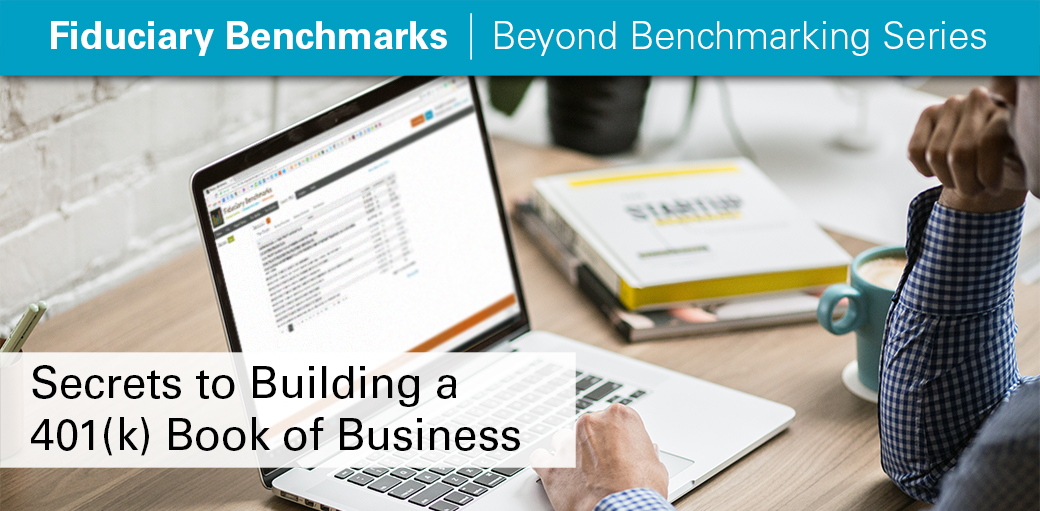Secrets to Building a 401(k) Book of Business
by Craig Rosenthal
Dec 05, 2018

Prospecting for 401(k) Clients
Whether you are starting out in the 401(k) industry or a seasoned professional – it all starts with an accurate prospect list. Who are the key decision makers that you can connect with so that you can share your story and earn their company’s retirement plan business?
Thankfully, in our industry, we have a huge advantage: the Form 5500. As you may know, the Department of Labor (DOL) requires plan administrators to file this annual form by July 31st. It is available to anyone looking for plan information and can add value to your prospect list. The form holds crucial contact information such as decision makers names, addresses, and phone numbers as well as valuable prospecting data points such as total plan assets, annual contributions, number of participants, and much more.
To get started, you will want to identify your target market. Start with the familiar and work outwards. Below are a few recommendations to help you identify and add new companies to your prospect pipeline:
- Existing Relationships: Look for companies where you know a company decision maker
- Internal Referrals: Speak with your colleagues and Centers of Influence relationships to identify companies where they know decision makers and would feel comfortable introducing you
- Family and Friends: Find companies that your family and friends work at
- Character Matches: Search for companies that share similar characteristics within your retirement plan book of business, such as related companies, similar industries, or competitors
- Focus on Interests: If you have a particular niche you are interested in feel free to focus efforts on those types of companies. For example, if you are a beer connoisseur you could search for local breweries
- Local Area: Identify companies that are within a short radius from your office
Then use the analytical power of LinkedIn to discover how you might be able to connect with the key decision makers. One the best ways to do this is through social media. Find the plan administrator’s name and then look them up on LinkedIn. Are they a connection or a 2nd degree connection?
- 1st degree connection. Reach out and ask for a meeting because you have some information about their company’s retirement plan that you believe they will find interesting and useful.
- 2nd degree connection. Use your social network to your advantage: lean on your “Mutual Connections.” Then ask your strongest relationship how they know the plan administrator. If it’s a favorable relationship, then ask if they would be open to sending a professional introduction email.
- 3rd degree connection or higher. Move on. There are a lot more approachable opportunities. (In future blog articles, we will discuss how to approach cold prospects.)
Once you have a focused prospect list, it’s time to run meaningful plan characteristic reports. According to a recent Fidelity study, plan sponsors are seeking efficient and reliable support. They want to work with retirement experts and better understand the following areas:
- Improving plan performance
- Managing fiduciary responsibilities
- Reasonable costs
Any one of these concerns could be the key to winning that plan. After running reports and evaluating the Form 5500 public data, select a visible pain point such as low participation, investment share class or unreasonable fees. Armed with this valuable information, develop a value proposition that addresses the issue.
For example, share with the company decision maker why you believe it is beneficial for them to setup a meeting, such as:
- Improving plan performance. Unemployment rates are at an all-time 17 year low. Great news for the economy, possible troubling news for your recruiting efforts. We strive to help employers create a competitive benefit plan that attracts top employees and promotes company growth.
- Managing fiduciary responsibilities. Is your company’s retirement plan exposing executive management to high levels of fiduciary risk? Regularly reviewing your retirement plan is a way to limit potential fiduciary liability. When was the last time you conducted a thorough audit?
- Reasonable fees. Over the past decade, many employers have had conversations about lowering their plan fees. However, it is equally important to discuss the quality, service, and value they are receiving from their service providers both as a plan fiduciary and as a good consumer.
Then complete your outreach by asking for a meeting with the decision maker. For example, “We recently ran a retirement plan report and found some interesting information that we’d like to share with you. How is your calendar next week for a conversation?”
By prospecting within your known network, this is an easy way for retirement plan advisors to open 401(k) opportunities and grow their business. It is also a chance for the advisor to demonstrate their expertise by presenting compelling reports that seek to address the plan’s problem and solve a need.
Lastly, by developing a consistent workflow process within your business, you can build a pipeline of qualified prospects and convert them into retirement plan clients.
Source: “Plan Sponsor Attitudes 9th Edition Survey Results.” Fidelity. 2018. https://institutional.fidelity.com/app/item/RD_13569_26306.html
About Author:

Craig Rosenthal, Head of Strategy and Chief Marketing Officer
Craig is Head of Strategy and Chief Marketing Officer for Fiduciary Decisions. In this role, he is responsible for driving Product and Partnership strategy as well as the overall messaging and marketing for the firm.


